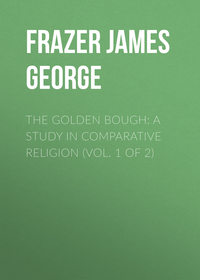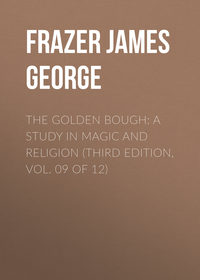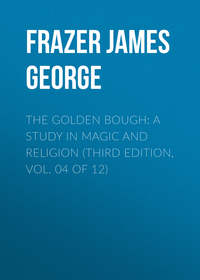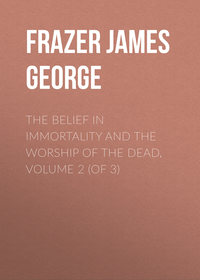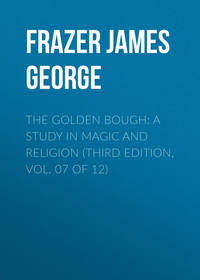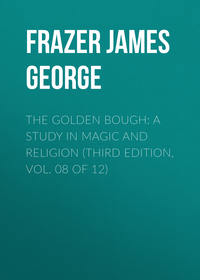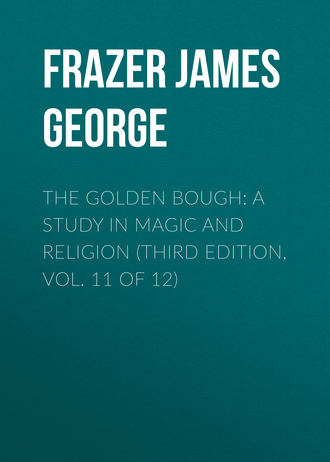
The Golden Bough: A Study in Magic and Religion (Third Edition, Vol. 11 of 12)
633
Rev. Lorimer Fison, op. cit. p. 26; Basil Thomson, op. cit. 147.
634
Rev. Lorimer Fison, op. cit. pp. 27 sq. The phrase “the ancestral gods” is used by Mr. Fison, one of our best authorities on Fijian religion. Mr. Basil Thomson (op. cit. p. 157) questions the accuracy of Mr. Fison's account of this vicarious sacrifice on the ground that every youth was regularly circumcised as a matter of course. But there seems to be no inconsistency between the two statements. While custom required that every youth should be circumcised, the exact time for performing the ceremony need not have been rigidly prescribed; and if a saving or atoning virtue was attributed to the sacrifice of foreskins, it might be thought desirable in cases of emergency, such as serious illness, to anticipate it for the benefit of the sufferer.
635
According to Mr. Fison, the enclosure was divided into three compartments; Mr. Basil Thomson describes only two, though by speaking of one of them as the “Middle Nanga” he seems to imply that there were three. The structure was a rough parallelogram lying east and west, about a hundred feet long by fifty feet broad, enclosed by walls or rows of stone slabs embedded endwise in the earth. See Basil Thomson, op. cit. pp. 147 sq.
636
A. B. Joske, “The Nanga of Vitilevu,” Internationales Archiv für Ethnographie, ii. (1889) p. 259; Basil Thomson, The Fijians, pp. 150 sq. According to Mr. Fison (op. cit. p. 19) the initiatory ceremonies were held as a rule only every second year; but he adds: “This period, however, is not necessarily restricted to two years. There are always a number of youths who are growing to the proper age, and the length of the interval depends upon the decision of the elders.” Perhaps the seeming discrepancy between our authorities on this point may be explained by Mr. Joske's statement (p. 259) that the rites are held in alternate years by two different sets of men, the Kai Vesina and the Kai Rukuruku, both of whom claim to be descended from the original founders of the rites. The custom of dating the New Year by observation of the Pleiades was apparently universal among the Polynesians. See The Spirits of the Corn and of the Wild, i. 312 sq.
637
Rev. Lorimer Fison, op. cit. pp. 20-23; A. B. Joske, op. cit. pp. 264 sq.; Basil Thomson, The Fijians, pp. 150-153. The sacramental character of the meal is recognized by Mr. Fison, who says (p. 23) that after the performance of the rites the novices “are now Vīlavóu, accepted members of the Nanga, qualified to take their place among the men of the community, though still only on probation. As children – their childhood being indicated by their shaven heads – they were presented to the ancestors, and their acceptance was notified by what (looking at the matter from the natives' standpoint) we might, without irreverance, almost call the sacrament of food and water, too sacred even for the elders' hands to touch.”
638
Paul Reina, “Ueber die Bewohner der Insel Rook,” Zeitschrift für allgemeine Erdkunde, N.F., iv. (1858) pp. 356 sq.
639
R. Parkinson, Im Bismarck Archipel (Leipsic, 1887), pp. 129-134; id. Dreissig Jahre in der Südsee (Stuttgart, 1907), pp. 567 sqq.; Rev. G. Brown, “Notes on the Duke of York Group, New Britain, and New Ireland,” Journal of the Royal Geographical Society, xlvii. (1878) pp. 148 sq.; H. H. Romilly, “The Islands of the New Britain Group,” Proceedings of the Royal Geographical Society, N.S., ix. (1887) pp. 11 sq.; Rev. G. Brown, ibid. p. 17; id., Melanesians and Polynesians (London, 1910), pp. 60 sqq.; W. Powell, Wanderings in a Wild Country (London, 1883), pp. 60-66; C. Hager, Kaiser Wilhelm's Land und der Bismarck Archipel (Leipsic, n. d.), pp. 115-128; Hubner, quoted by W. H. Dall, “On masks, labrets, and certain aboriginal customs,” Third Annual Report of the Bureau of Ethnology (Washington, 1884), p. 100; P. A. Kleintitschen, Die Küstenbewohner der Gazellehalbinsel (Hiltrup bei Münster, n. d.), pp. 350 sqq.; H. Schurtz, Altersklassen und Männerbünde (Berlin, 1902), pp. 369-377. The inhabitants of these islands are divided into two exogamous classes, which in the Duke of York Island have two insects for their totems. One of the insects is the mantis religiosus; the other is an insect that mimics the leaf of the horse-chestnut tree very closely. See Rev. B. Danks, “Marriage Customs of the New Britain Group,” Journal of the Anthropological Institute, xviii. (1889) pp. 281 sq.; Totemism and Exogamy, ii. 118 sqq.
640
J. G. F. Riedel, “Galela und Tobeloresen,” Zeitschrift für Ethnologie, xvii. (1885) pp. 81 sq.
641
The Kakian association and its initiatory ceremonies have often been described. See François Valentyn, Oud en nieuw Oost-Indiën (Dordrecht and Amsterdam, 1724-1726), iii. 3 sq.; Von Schmid, “Het Kakihansch Verbond op het eiland Ceram,” Tijdschrift voor Neérlands Indië (Batavia, 1843), dl. ii. pp. 25-38; A. van Ekris, “Het Ceramsche Kakianverbond,” Mededeelingen van wege het Nederlandsche Zendelinggenootschap, ix. (1865) pp. 205-226 (repeated with slight changes in Tijdschrift voor Indische Taal- Land- en Volkenkunde, xvi. (1867) pp. 290-315); P. Fournier, “De Zuidkust van Ceram,” Tijdschrift voor Indische Taal- Land- en Volkenkunde, xvi. (1867) pp. 154-156; W. A. van Rees, Die Pionniers der Beschaving in Neêrlands Indië (Arnheim, 1867), pp. 92-106; G. W. W. C. Baron van Hoëvell, Ambon en meer bepaaldelijk de Oeliasers (Dordrecht, 1875), pp. 153 sqq.; Schulze, “Ueber Ceram und seine Bewohner,” Verhandlungen der Berliner Gesellschaft für Anthropologie, Ethnologie, und Urgeschichte (1877), p. 117; W. Joest, “Beiträge zur Kenntniss der Eingebornen der Insel Formosa und Ceram,” ibid. (1882) p. 64; H. von Rosenberg, Der Malayische Archipel (Leipsic, 1878), p. 318; A. Bastian, Indonesien, i. (Berlin, 1884) pp. 145-148; J. G. F. Riedel, De sluik- en kroesharige rassen tusschen Selebes en Papua (The Hague, 1886), pp. 107-111; O. D. Tauern, “Ceram,” Zeitschrift für Ethnologie, xlv. (1913) pp. 167 sq. The best accounts are those of Valentyn, Von Schmid, Van Ekris, Van Rees, and Riedel, which are accordingly followed in the text.
642
No reason is assigned for this curious choice of a president. Can it have been that, because negro children are born pale or nearly white, an albino was deemed a proper president for a society, all the initiated members of which claimed to have been born again? Speaking of the people of the Lower Congo the old English traveller Andrew Battel observes that “the children of this country are born white, but change their colour in two days' time to a perfect black” (“Adventures of Andrew Battel,” in J. Pinkerton's Voyages and Travels, xvi. London, 1814, p. 331).
643
Rev. J. H. Weeks, “Notes on some Customs of the Lower Congo People,” Folk-lore, xx. (1909) pp. 189-198; Rev. W. H. Bentley, Life on the Congo (London, 1887), pp. 78 sq.; id., Pioneering on the Congo (London, 1900), i. 284-287. Mr. Weeks's description of the institution is the fullest and I have followed it in the text. The custom was in vogue down to recent years, but seems to have been suppressed chiefly by the exertions of the missionaries. Besides the ndembo guild there is, or was, in these regions another secret society known as the nkimba, which some writers have confused with the ndembo. The nkimba was of a more harmless character than the other; indeed it seems even to have served some useful purposes, partly as a kind of freemasonry which encouraged mutual help among its members, partly as a system of police for the repression of crime, its professed object being to put down witchcraft and punish witches. Only males were admitted to it. Candidates for initiation were stupefied by a drug, but there was apparently no pretence of killing them and bringing them to life again. Members of the society had a home in the jungle away from the town, where the novices lived together for a period varying from six months to two years. They learned a secret language, and received new names; it was afterwards an offence to call a man by the name of his childhood. Instead of the red dye affected by members of the ndembo guild, members of the nkimba guild whitened their bodies with pipe clay and wore crinolines of palm frondlets. See Rev. W. H. Bentley, Life on the Congo, pp. 80-83; id., Pioneering on the Congo, i. 282-284; Rev. J. H. Weeks, op. cit. pp. 198-201; (Sir) H. H. Johnston, “A Visit to Mr. Stanley's Stations on the River Congo,” Proceedings of the Royal Geographical Society, N. S. v. (1883) pp. 572 sq.; E. Delmar Morgan, “Notes on the Lower Congo,” id., N.S. vi. (1884) p. 193. As to these two secret societies on the Lower Congo, see further (Sir) H. H. Johnston, “On the Races of the Congo,” Journal of the Anthropological Institute, xiii. (1884) pp. 472 sq.; É. Dupont, Lettres sur le Congo (Paris, 1889), pp. 96-100; Herbert Ward, Five Years with the Congo Cannibals (London, 1890), pp. 54 sq.; id. “Ethnographical Notes relating to the Congo Tribes,” Journal of the Anthropological Institute, xxiv. (1895) pp. 288 sq.; E. J. Glave, Six Years of Adventure in Congo Land (London, 1893), pp. 80-83; L. Frobenius, Die Masken und Geheimbünde Afrikas (Halle, 1898), pp. 43-54 (Nova Acta. Abh. der Kaiserl. Leop. Carol. Deutschen Akademie der Naturforscher, vol. lxxiv. No. 1); H. Schurtz, Altersklassen und Männerbünde (Berlin, 1902), pp. 433-437; Notes Annalytiques sur les Collections Ethnographiques du Musée du Congo (Brussels, 1902-1906), pp. 199-206; Ed. de Jonghe, Les Sociétés Secrètes au Bas-Congo (Brussels, 1907), pp. 15 sqq. (extract from the Revue des Questions Scientifiques, October 1907). Some of these writers do not discriminate between the two societies, the ndembo and the nkimba. According to our best authorities (Messrs. Bentley and Weeks) the two societies are quite distinct and neither of them has anything to do with circumcision, which is, however, prevalent in the region. See Rev. J. H. Weeks, “Notes on some Customs of the Lower Congo People,” Folk-lore, xx. (1909) pp. 304 sqq. A secret society of the Lower Congo which Adolf Bastian has described under the name of quimba is probably identical with the nkimba. He speaks of a “Secret Order of those who have been born again,” and tells us that the candidates “are thrown into a death-like state and buried in the fetish house. When they are wakened to life again, they have (as in the Belliparo) lost their memory of everything that is past, even of their father and mother, and they can no longer remember their own name. Hence new names are given them according to the titles or ranks to which they are advanced.” See A. Bastian, Die deutsche Expedition an der Loango-Küste (Jena, 1874-1875), ii. 15 sqq.
644
A. Bastian, Ein Besuch in San Salvador (Bremen, 1859), pp. 82 sq.
645
A. Bastian, Die deutsche Expedition an der Loango-Küste, ii. 183. Elsewhere Bastian says that about San Salvador lads at puberty are secluded in the forest and circumcised, and during their seclusion “each of them is mystically united to the fetish by which his life is henceforth determined, as the Brahman whispers the secret charm in the ear of him who has been born again.” See A. Bastian, Ein Besuch in San Salvador (Bremen, 1859), pp. 85 sq.
646
H. Trilles, Le Totémisme chez les Fâṅ (Münster i. W., 1912), pp. 479 sq. The writer speaks of the guardian spirit as the individual totem of the young warrior.
647
O. Dapper, Description de l'Afrique (Amsterdam, 1686), pp. 268 sq. Dapper's account has been abridged in the text.
648
Miss Mary H. Kingsley, Travels in West Africa (London, 1867), p. 531. Perhaps the smearing with clay may be intended to indicate that the novices have undergone the new birth; for the negro child, though born reddish-brown, soon turns slaty-grey (E. B. Tylor, Anthropology, London, 1881, p. 67), which would answer well enough to the hue of the clay-bedaubed novices.
649
Thomas Winterbottom, An Account of the Native Africans in the Neighbourhood of Sierra Leone (London, 1803), pp. 135 sq. Compare John Matthews, A Voyage to the River Sierra-Leone (London, 1791), pp. 82-85; J. B. L. Durand, Voyage au Sénégal (Paris, 1802), pp. 183 sq. (whose account is copied without acknowledgment from Matthews). The purra or poro society also exists among the Timmes of Sierra Leone; in this tribe the novices are sometimes secluded from their families for ten years in the wood, they are tattooed on their backs and arms, and they learn a language which consists chiefly of names of plants and animals used in special senses. Women are not admitted to the society. See Zweifel et Moustier, “Voyage aux sources du Niger,” Bulletin de la Société de Géographie (Paris), VI. Série, xv. (1878) pp. 108 sq.
650
T. J. Alldridge, The Sherbro and its Hinterland (London, 1901), p. 130. This work contains a comparatively full account of the purra or poro society (pp. 124-131) and of the other secret societies of the country (pp. 131-149, 153-159). Compare L. Frobenius, Die Masken und Geheimbünde Afrikas (Halle, 1898), pp. 138-144 (Nova Acta, Abh. der Kaiserl. Leop. – Carol. Deutschen Akademie der Naturforscher, vol. lxxiv. No. 1).
651
Thomas Winterbottom, An Account of the Native Africans in the Neighbourhood of Sierra Leone (London, 1803), pp. 137-139. As to the semo or simo society see further L. Frobenius, op. cit. pp. 130-138.
652
Extract from a letter of Mr. A. C. Hollis to me. Mr. Hollis's authority is Dr. T. W. W. Crawford of the Kenia Medical Mission.
653
W. Scoresby Routledge and Katherine Routledge, With a Prehistoric People, the Akikuyu of British East Africa (London, 1910), p. 152. Compare C. W. Hobley, “Kikuyu Customs and Beliefs,” Journal of the Royal Anthropological Institute, xl. (1910) p. 441.
654
Mr. A. W. McGregor, of the Church Missionary Society, quoted by W. S. Routledge and K. Routledge, With a Prehistoric People, p. 151, note. 1. Mr. McGregor “has resided amongst the Akikuyu since 1901. He has by his tact and kindness won the confidence of the natives, and is the greatest authority on their language” (id., p. xxi).
655
W. S. Routledge and K. Routledge, op. cit. p. 151.
656
Rev. G. Dale, “An Account of the principal Customs and Habits of the Natives inhabiting the Bondei Country,” Journal of the Anthropological Institute, xxv. (1896) p. 189.
657
E. Torday et T. A. Joyce, Les Bushongo (Brussels, 1910), pp. 82-85. As for the title “God on Earth,” applied to the principal chief or king, see id., p. 53.
658
(Beverley's) History of Virginia (London, 1722), pp. 177 sq. Compare J. Bricknell, The Natural History of North Carolina (Dublin, 1737), pp. 405 sq.
659
J. Carver, Travels through the Interior Parts of North America, Third Edition (London, 1781), pp. 271-275. The thing thrown at the man and afterwards vomited by him was probably not a bean but a small white sea-shell (Cypraea moneta). See H. R. Schoolcraft, Indian Tribes of the United States (Philadelphia, 1853-1856), iii. 287; J. G. Kohl, Kitschi-Gami (Bremen, 1859), i. 71; Seventh Annual Report of the Bureau of Ethnology (Washington, 1891), pp. 191, 215; Fourteenth Annual Report of the Bureau of Ethnology (Washington, 1896), p. 101.
660
J. Carver, op. cit. pp. 277 sq.; H. R. Schoolcraft, Indian Tribes of the United States, iii. 287 (as to the Winnebagoes), v. 430 sqq. (as to the Chippeways and Sioux); J. G. Kohl, Kitschi-Gami, i. 64-70 (as to the Ojebways). For a very detailed account of the Ojebway ceremonies, see W. J. Hoffman, “The Midewiwin or Grand Medicine Society of the Ojibwa,” Seventh Annual Report of the Bureau of Ethnology (Washington, 1891), especially pp. 215 sq., 234 sq., 248, 265. For similar ceremonies among the Menomini, see id., “The Menomini Indians,” Fourteenth Annual Report of the Bureau of Ethnology (Washington, 1896), pp. 99-102; and among the Omahas, see J. Owen Dorsey, “Omaha Sociology,” Third Annual Report of the Bureau of Ethnology (Washington, 1884), pp. 342-346. I have dealt more fully with the ritual in Totemism and Exogamy, iii. 462 sqq. Compare also P. Radin, “Ritual and Significance of the Winnebago Medicine Dance,” Journal of American Folk-lore, xxiv. (1911) pp. 149-208.
661
G. H. Pond, “Dakota superstitions,” Collections of the Minnesota Historical Society for the year 1867 (Saint Paul, 1867), pp. 35, 37-40. A similar but abridged account of the Dakota tradition and usage is given by S. R. Riggs in his Dakota Grammar, Texts, and Ethnography (Washington, 1893), pp. 227-229 (Contributions to North American Ethnology, vol. ix.).
662
Narrative of the Adventures and Sufferings of John R. Jewitt (Middletown, 1820), p. 119.
663
Id., p. 44. For the age of the prince, see id., p. 35.
664
H. J. Holmberg, “Ueber die Völker des russischen Amerika,” Acta Societatis Scientiarum Fennicae, iv. (Helsingfors, 1856) pp. 292 sqq., 328; Ivan Petroff, Report on the Population, Industries and Resources of Alaska, pp. 165 sq.; A. Krause, Die Tlinkit-Indianer (Jena, 1885), p. 112; R. C. Mayne, Four Years in British Columbia and Vancouver Island (London, 1862), pp. 257 sq., 268; Totemism and Exogamy, iii. 264 sqq.
665
Fr. Boas, in Sixth Report on the North-Western Tribes of Canada, pp. 47 sq. (separate reprint from the Report of the British Association, Leeds meeting, 1890); id., “The Social Organization and the Secret Societies of the Kwakiutl Indians,” Report of the United States National Museum for 1895; (Washington, 1897), pp. 632 sq. But while the initiation described in the text was into a wolf society, not into a wolf clan, it is to be observed that the wolf is one of the regular totems of the Nootka Indians. See Fr. Boas, in Sixth Report on the North-Western Tribes of Canada, p. 32.
666
Fr. Boas, in Tenth Report on the North-Western Tribes of Canada, pp. 49 sq., 58 sq. (separate reprint from the Report of the British Association, Ipswich meeting, 1895). It is remarkable, however, that in this tribe persons who are being initiated into the secret societies, of which there are six, are not always or even generally brought back by an artificial animal which represents their own totem. Thus while men of the eagle totem are brought back by an eagle which rises from underground, men of the bear clan return on the back of an artificial killer-whale which is towed across the river by ropes. Again, members of the wolf clan are brought back by an artificial bear, and members of the raven clan by a frog. In former times the appearance of the artificial totem animal, or of the guardian spirit, was considered a matter of great importance, and any failure which disclosed the deception to the uninitiated was deemed a grave misfortune which could only be atoned for by the death of the persons concerned in the disclosure.
667
See above, p. 213.
668
This is the opinion of Dr. F. Boas, who writes: “The close similarity between the clan legends and those of the acquisition of spirits presiding over secret societies, as well as the intimate relation between these and the social organizations of the tribes, allow us to apply the same argument to the consideration of the growth of the secret societies, and lead us to the conclusion that the same psychical factor that molded the clans into their present shape molded the secret societies” (“The Social Organization and the Secret Societies of the Kwakiutl Indians,” Report of the United States National Museum for 1895, p. 662). Dr. Boas would see in the acquisition of a manitoo or personal totem the origin both of the secret societies and of the totem clans; for according to him the totem of the clan is merely the manitoo or personal totem of the ancestor transmitted by inheritance to his descendants. As to personal totems or guardian spirits (manitoos) among the North American Indians, see Totemism and Exogamy, iii. 370 sqq.; as to their secret societies, see id., iii. 457 sqq.; as to the theory that clan totems originated in personal or individual totems, see id., iv. 48 sqq.
669
A. G. Morice, “Notes, archaeological, industrial, and sociological, on the Western Dénés,” Transactions of the Canadian Institute, iv. (1892-93) pp. 203-206. The honorific totems of the Carrier Indians may perhaps correspond in some measure to the sub-totems or multiplex totems of the Australians. As to these latter see Totemism and Exogamy, i. 78 sqq., 133 sqq.
670
See above, pp. 153 sq.
671
James Teit, The Thompson Indians of British Columbia, p. 357 (The Jesup North Pacific Expedition, Memoir of the American Museum of Natural History, April, 1900). Among the Shuswap of British Columbia, when a young man has obtained his personal totem or guardian spirit, he is supposed to become proof against bullets and arrows (Fr. Boas, in Sixth Report of the Committee on the North-Western Tribes of Canada, p. 93, separate reprint from the Report of the British Association, Leeds meeting, 1890).
672
H. R. Schoolcraft, Indian Tribes of the United States (Philadelphia, 1853-1856), v. 683. In a letter dated 16th Dec. 1887, Mr. A. S. Gatschet, formerly of the Bureau of Ethnology, Washington, wrote to me: “Among the Toukawe whom in 1884 I found at Fort Griffin [?], Texas, I noticed that they never kill the big or grey wolf, hatchukunän, which has a mythological signification, ‘holding the earth’ (hatch). He forms one of their totem clans, and they have had a dance in his honor, danced by the males only, who carried sticks.”
673
The Laws of Manu, ii. 169, translated by G. Bühler (Oxford, 1886), p. 61 (The Sacred Books of the East, vol. xxv.); J. A. Dubois, Mœurs, Institutions et Cérémonies des Peuples de l'Inde (Paris, 1825), i. 125; Monier Williams, Religious Thought and Life in India (London, 1883), pp. 360 sq., 396 sq.; H. Oldenberg, Die Religion des Veda (Berlin, 1894), pp. 466 sqq.


